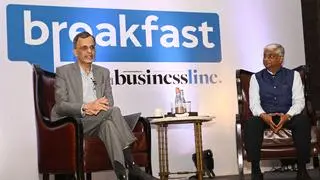Monetary tightening measures and pressure on disposable incomes from soaring food prices seem to be hurting industrial growth, which has plunged to a 21-month low of 1.6 per cent.
The 1.6 per cent year-on-year rise in the official Index of Industrial Production (IIP) for December – the lowest since the 0.9 per cent in March 2009 – is partly a result of the so-called base effect: The same month of the previous year returned an all-time-high growth rate of 18 per cent (see Table).
But even after discounting for the higher base growth figure, a second consecutive month of lacklustre factory output increase appears to confirm industry fears of the economy losing traction.
“The growth of the manufacturing sector is moderating,” said Mr Rajan Bharti Mittal, President of the Federation of Indian Chambers of Commerce and Industry, while urging a “cautionary” approach against any further interest rate hikes or withdrawal of fiscal stimulus in the coming Union Budget.
“Disappointing”
While the Finance Minister, Mr Pranab Mukherjee, termed the December numbers as “very unfortunate and disappointing”, the Planning Commission Deputy Chairman, Mr Montek Singh Ahluwalia, was still hopeful of an 8 per cent industrial growth for 2010-11 as a whole.
But even that may not be easy. Although the cumulative annual growth for April-December works out to 8.6 per cent – the same as that of the corresponding three quarters of 2009-10 – the ‘base effect' could translate into lower IIP increases in the remaining three months of this fiscal.
The deceleration in December has come mainly from manufacturing, which grew by a minuscule one per cent, as against 19.6 per cent in the corresponding month of the previous year. While mining, too, grew at a lower pace (3.8 per cent versus 11.1 per cent), electricity registered an acceleration (6 per cent versus 5.4 per cent).
For the April-December 2010-11 period, manufacturing growth stood at 9.1 per cent (8.9 per cent), while amounting to 7.7 per cent (8.7 per cent) for mining and 4.7 per cent (5.7 per cent) for electricity.
Within manufacturing, the segment that has shown the worst performance in December is capital goods, which has record a 13.7 per cent year-on-year decline. This negative growth – compared with a 42.9 per cent growth in the same month of 2009 – is significant because capital goods are seen as a proxy for investment activity in the economy.
Another subsector that has done poorly is consumer non-durables – a minus 1.1 per cent growth on top of 3 per cent in December 2009. The underlying trigger may have been food inflation, which has forced consumers (particularly poor and lower-middle) to cut back spending on non-essentials.
At the same time, production of consumer durables has gone up by 18.5 per cent (against 41 per cent in December 2009), while the corresponding growth rates were 5.2 per cent (8.4 per cent) for basic goods and 6.6 per cent (23.5 per cent) for intermediate goods.
During April-December, capital goods output grew by 16.7 per cent (against 11.2 per cent during the corresponding three quarters of 2009-10), with these being 6.1 per cent (6.1 per cent) for basic goods, 9.2 per cent (12.5 per cent) for intermediate goods, 21.4 per cent (22.7 per cent) for consumer durables and 0.7 per cent (1.4 per cent) for consumer non-durables.








Comments
Comments have to be in English, and in full sentences. They cannot be abusive or personal. Please abide by our community guidelines for posting your comments.
We have migrated to a new commenting platform. If you are already a registered user of TheHindu Businessline and logged in, you may continue to engage with our articles. If you do not have an account please register and login to post comments. Users can access their older comments by logging into their accounts on Vuukle.